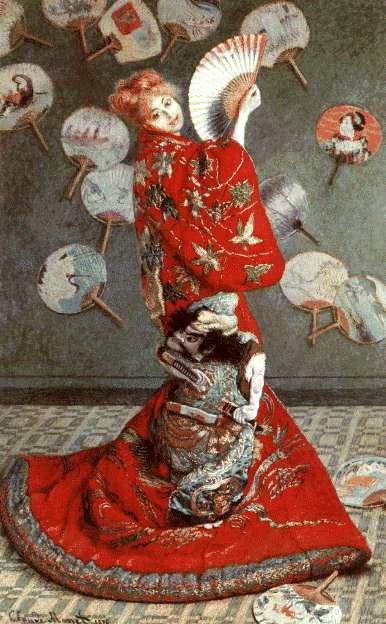
The last series of paintings I have done are relatively small in size. For example the one on the right, "Away" is under 2 feet. Certainly going to any gallery with contemporary paintings, 2 feet feels exceedingly small. However if one takes a look at some of Degas' work, it is surprisingly small. Off the top of my head, most of the impressionist work I've seen is small (I'm thinking of the MFA Boston collection in particular because that is where I spent many long hours looking at it when I lived in the area.) The only larger size paintings that I remember are Monet's "La Japonaise" (roughly 232x142cm or 7.6x4.7feet)
 which dominates one wall of the room, Manet's "Execution of the Emperor Maximilian" (roughly 196x259cm or 6.3x8.5 feet), and Monet's almost abstract large scale water lily paintings (which I saw at the Monet exhibition, they are not part of the MFA collection.)
which dominates one wall of the room, Manet's "Execution of the Emperor Maximilian" (roughly 196x259cm or 6.3x8.5 feet), and Monet's almost abstract large scale water lily paintings (which I saw at the Monet exhibition, they are not part of the MFA collection.) In art school there was always the pressure to paint big (over 6 feet big) which at the time I, being 19, thought was only an example of "bigger-is-better-itis" that is inflicting our patriarchal consumerist society, those are the terms I saw the world in then. I held out for a while, arguing that most people don't have space to hang 7 + foot paintings in their homes so they're really not marketable (not really grasping that most people can't afford to buy paintings for their homes) and then begrudgingly went about making large paintings. The problems I had in art school with size and scale were numerous. Often I would make the same paintings I would make small, but just increase the scale. Many of my paintings were giant faces which made my art teachers fill my arms with books and books about Chuck Close and of course I didn't understand why. And on top of painting giant heads, I had no money and only bought cheap tiny brushes giving everthing a very uniform brushstroke throughout. Again, I was not aware I was doing this though art teachers told me. But this last year it has been like all the things I was being told in critiques just sunk in and now I understand what I didn't when I was 19.
Now that I have no teachers telling me to paint bigger, I have finally been able to paint small. And it was seeing some tiny Degas (don't remember which ones or where) that moved me to follow my gut. While the paintings were small, it were of full figures and settings, and fully realized. If seen in a book one would probably assume it was much larger. But what really compelled me was the fluidity of the paint-- how a single confident brush stroke could high light at arm-- that was all it took. I wanted to do that but I always had too much area to fill in with a tiny brush. So I starting painting small scenes and really working on building my brustrokes, color, and confidence. By working small I started to master the paint more, get a better feel of it.
And after really working like this for a while, I felt the need to get larger. So I made larger canvases. And this time I really paid attention to the relationship between the viewer and the painting. First of all, if painting a figure larger than life size-- it stands out as larger than life. There are two reasons to paint larger than life: to give an overwhelming effect to the up close viewer, or appear life-size to the viewer if the painting is displayed up high or at a distance. I did not want to overwhelm the viewer-- not like Chuck Close. (Why is it that a viewer can relate to smaller figures rather than huge ones in pictures?) So with my larger paintings I took great pains to scale my subject proportionally with the frame of the canvas-- though still larger than my smaller paintings. And as I paint the larger paintings, I paying attention to the proportion of the brush to the painted image as well as the canvas. If I vary the size of the brush, I can control the focus of the painting much like a camera-- though not in planes of depth of field but in how the eye travels. The eye will go to areas with finer detail and more painted work. And if I contrast the fine detailing with broader, bigger, and bolder brushstrokes, the eye will interpret that as more peripheral. Plus having worked small for a while and mastered a small amount of paint, it is really showing in the larger paintings. They look more confident than my old paintings, and that is good. I hope to someday be as good at painting as I am at drawing (another thing that was told to me in art school. ) Though I still don't know why, in todays world where there hardly any frescos and murals, there is the pressure to make giant paintings-- as if that makes one a serious artist. I know that it is unlikely that I will go larger than 7'anytime soon-- at least until I get more space since my ceilings are only 7'6" high. I will post some of my college/high school work for contrast some day.
No comments:
Post a Comment